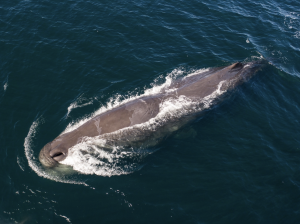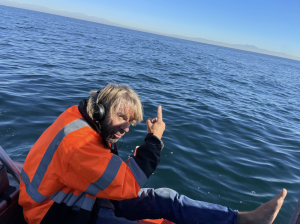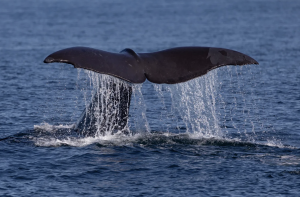By LAYLAN CONNELLY
Eric Martin listened to the sounds of the underwater world using a contraption he pieced together with Tupperware and plastic piping.
The water can be a noisy place, especially with the roaring engine noise from all the massive cargo ships moving around offshore. But Martin, the head aquarist for the Roundhouse Aquarium in Manhattan Beach, knows how to hone in and detect the distinct clicking noise unique to only one sea creature: the endangered sperm whale.
“I think I got it,” Martin said Wednesday, Oct. 27, while aboard Newport Coastal Adventure’s charter boat out searching for a sperm whale half way between Catalina and Orange County, the same seen the previous day off San Pedro’s coast.
Having a close encounter with a massive sperm whale – a year since one was seen off Palos Verdes and five years since one was encountered off Orange County – is a treat in itself. But Martin’s method using an hydrophone – an underwater device that can detect sounds from all directions – to track down the elusive whale made this encounter extra exciting.
When word spread a sperm whale was spotted Tuesday off South Bay, first by Harbor Breeze Cruises, Newport Coastal Adventure Capt. Ryan Lawler rushed up the coast to see for himself.
But sperm whales dive deep while hunting for squid, often staying down for 40 minutes at a time, making them hard to track.
“Sperm whales, how they live, they just are down there clicking around, sending out echolocation sounds trying to find food,” Lawler said. That makes the hydrophone useful.
Sperm whales are an interesting creature that “just look really weird,” Lawler said, noting it’s the largest member of the toothed-whale family.
The whales have one big blowhole, not two like other whales, and it’s on the side of its head rather than on the top.
“The spout does not shoot straight up, it shoots at a 45-degree angle,” Lawler said. “Even that alone is really weird, to see a whale spout off to the side, not straight up and down.”
The endangered animal – this one is about 50-feet long – is hard to come by, with whalers previously decimating the population by hunting the species for its oil.
Sperm whales are named for the waxy substance, called spermaceti, found in their head cavities, according to the National Oceanic Atmospheric Administration. The spermaceti is an oil sac that helps the whales focus sound, and was used in oil lamps, lubricants and candles.
“They were just hunted ruthlessly,” Lawler said. “They are just a rare whale to see.”
The whale spotted this week, with distinct markings on its body, in particular seems to like Southern California waters. It is the same male spotted in 2020 off Palos Verdes and the previous year. Those years, the whale traveled with another male.
It makes sense the whale has reappeared in local waters, Lawler said. Lately, there’s also been a lot of Risso’s dolphins and swordfish, both also feed on squid.
Martin, who has been whale watching since 1984, said he first got his hydrophone back in the late ’80s when a sperm whale – called Two Scoops for the chunks taken out of its fluke – came to town.
“He would always show up in our waters, sometimes bringing a friend,” causing Martin to wonder, “How am I going to find this guy when he stays down for 30 minutes?”
Martin said he had heard of people using hydrophones in the Galapagos Islands and bought one from a catalog for $25. Then, a few years later, he upgraded to a version he heard researchers were using in Canada. He rigged two Tupperware bowls to hold it in place, glued wetsuit material around it and used PVC piping for the connection. He listens with his headphones.
“I can find anything that makes a sound, as long as it’s consistent,” he said. “For years, I’d be going out in the middle of the night trying to find animals using the hydrophone.”
Through the years, anytime a sperm whale comes to town, Martin’s the man with the machine, and the patience, to find them.
When Lawler first saw Martin’s makeshift contraption, he said he was skeptical as they watched him listen for hours. “Does this guy really know what he’s doing?”
Then, just as they were about to call it a day, Martin heard a faint noise among all the cargo ship sounds, a familiar repetition that suddenly stopped, as happens when the sperm whale is making its way back up to the surface.
Martin directed everyone to the stern and said, “He’s coming up. Keep your eyes open.”
The others on the boat screamed, “There it is!”
“They were just in awe of how well this thing actually works,” Martin said. “We stayed with it for three more surfacings.”
Other whale watching boats also arrived. Martin called it a beautiful day out on the water, despite the added pressure of having to prove his tech worked.
“Anything that makes noise,” he said, “I can find.”
Source: https://www.eastbaytimes.com/2021/10/29/elusive-sperm-whale-off-so-cal-coast-found-using-underwater-hydrophone/










